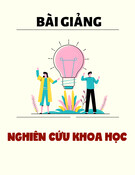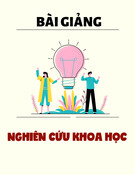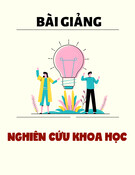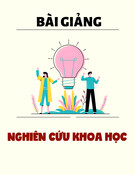
TNU Journal of Science and Technology
230(04): 154 - 161
http://jst.tnu.edu.vn 154 Email: jst@tnu.edu.vn
PRE-SERVICE TEACHERS’ AWARENESS AND BELIEFS ABOUT
DIFFERENTIATED INSTRUCTION IN EFL CLASSES:
IMPLICATIONS FOR TEACHER EDUCATION
Le Van Tuyen*, Tran Kim Hong, Vo Tran Minh Hieu, Nguyen Ha Linh Phuong
Ho Chi Minh City University of Technology (HUTECH University)
ARTICLE INFO
ABSTRACT
Received:
18/12/2024
Differentiated instruction has been proved to help EFL students obtain high
achievement in their learning. Understanding pre-service teachers’ awareness
and beliefs about differentiated instruction in an EFL context like Vietnam may
bring a variety of benefits to EFL teacher education. The current study, therefore,
aims to investigate pre-service teachers’ awareness and beliefs about the benefits
and challenges of differentiated instruction in EFL classes. The study was
conducted at Ho Chi Minh City of Technology with the participation of 70 pre-
service teachers. Both quantitative and qualitative data were collected through
the employment of the questionnaire and unstructured interviews; for data
analysis, “descriptive statistics” and “content analysis” were utilized. The
findings of the study revealed that most of the pre-service teachers are much
aware of differentiated instruction and hold common beliefs that differentiated
instruction may not only bring a variety of benefits but also cause challenges to
teachers and students. The study highlights the importance of awareness and
beliefs about differentiated instruction in EFL classes and provides meaningful
contributions to EFL teacher development to enhance the quality of teaching EFL
in Vietnam in particular, and in other EFL contexts in general.
Revised:
19/3/2025
Published:
20/3/2025
KEYWORDS
Differentiated instruction
Awareness
Beliefs
Pre-service students
EFL teacher education
NHẬN THỨC VÀ NIỀM TIN CỦA GIÁO SINH VỀ PHƯƠNG PHÁP
DẠY PHÂN HÓA TRONG CÁC LỚP TIẾNG ANH:
Ý NGHĨA ĐỐI VỚI VIỆC ĐÀO TẠO GIÁO VIÊN
Lê Văn Tuyên*, Trần Kim Hồng, Võ Trần Minh Hiếu, Nguyễn Hà Linh Phương
Trường Đại học Công nghệ Thành phố Hồ Chí Minh
THÔNG TIN BÀI BÁO
TÓM TẮT
Ngày nhận bài:
18/12/2024
Phương pháp dạy học phân hóa đã được chứng minh là có thể giúp học sinh tiếng
Anh đạt được kết quả cao trong học tập. Hiểu được nhận thức và niềm tin của
giáo sinh về phương pháp dạy học phân hóa trong bối cảnh tiếng Anh là một
ngoại ngữ như ở Việt Nam có thể mang lại nhiều lợi ích cho việc đào tạo giáo
viên tiếng Anh. Do đó, mục đích của nghiên cứu là tìm hiểu nhận thức và niềm
tin của giáo sinh tiếng Anh về phương pháp dạy học phân hóa áp dụng trong các
lớp tiếng Anh. Nghiên cứu được thực hiện tại trường Đại học Công nghệ Thành
phố Hồ Chí Minh với sự tham gia của 70 giáo sinh. Dữ liệu định lượng và định
tính được thu thập thông qua việc sử dụng bảng câu hỏi và phỏng vấn không cấu
trúc; phương pháp "thống kê mô tả" và "phân tích nội dung" đã được sử dụng để
phân tích kết quả. Kết quả nghiên cứu cho thấy hầu hết các giáo sinh đều nhận
thức rõ về phương pháp dạy học phân hóa và có niềm tin chung rằng phương
pháp này không chỉ mang lại nhiều lợi ích mà còn có thể gây ra thách thức cho
cả giáo viên và học sinh. Nghiên cứu nhấn mạnh tầm quan trọng của nhận thức
và niềm tin về phương pháp giảng dạy trong các lớp học tiếng Anh và mang lại
những đóng góp ý nghĩa trong việc phát triển giáo viên tiếng Anh nhằm nâng cao
chất lượng giảng dạy tiếng Anh tại Việt Nam nói riêng và trong các ngữ cảnh
khác nói chung.
Ngày hoàn thiện:
19/3/2025
Ngày đăng:
20/3/2025
TỪ KHÓA
Dạy học phân hóa
Nhận thức
Niềm tin
Giáo sinh
Đào tạo giáo viên tiếng Anh
DOI: https://doi.org/10.34238/tnu-jst.11736
* Corresponding author. Email: lv.tuyen@hutech.edu.vn

TNU Journal of Science and Technology
230(04): 154 - 161
http://jst.tnu.edu.vn 155 Email: jst@tnu.edu.vn
1. Introduction
In recent decades, language educators and researchers all over the world have paid much
attention to the issue of differentiated instruction (DI). This teaching approach has gained
increasing interest in all types of education, including English education with the aim of helping
teachers ensure equal access to education for all learners of different learning styles, interests and
background. DI is defined as a set of instructional strategies held as a way of thinking and a set of
principles used in planning and conducting a teaching and learning process [1]. Tomlinson [2] has
proposed four areas of differentiation: content, process, product and environment. Content refers
to the knowledge and skills mentioned in the materials, textbook or texts used in the classroom to
meet the needs of different learner groups of the class. Process refers to the learning activities,
tasks and classroom arrangement. Product refers to an assignment or a task which students are
required to complete (e.g., a letter, an essay, an interview, a show, a marketing plan), and
Environment refers to the place where learning takes place, e.g., classrooms. Interesting, friendly,
and supportive classrooms should be created for students. The above-mentioned areas can be
differentiated along three types of differences among students, including interests reflecting their
passions and motivation, learning profiles reflecting their learning styles, and cultural background,
and readiness levels reflecting their proximity to specified knowledge understanding and skills [1].
For over two decades language educators and researchers have conducted studies to investigate
the implementation of DI used in teaching English skills or knowledge, e.g., English vocabulary
[3], reading comprehension [4], assessing English learning [5], the impact of DI on English
listening performance [6] and English-speaking skills [7], and effects of DI on students’
achievements [8]. Regarding beliefs about DI, it can be found that most of the studies have focused
on in-service teachers’ beliefs about DI instead of pre-service teachers (PTs), e.g., teachers’ beliefs
about DI in mixed ability classrooms [9], teachers’ beliefs and practices in DI [10], or teachers’
beliefs and attitudes towards DI [11]. Very few studies have been found to investigate issues in DI
with the participation of PTs [12].
In the Vietnamese context, in the last decade, Vietnam’s general education system has also
focused on the employment of DI in the implementation of subjects or courses from primary
schools to tertiary institutions as stated in the draft of the new general education program by
Ministry of Education and Training of Vietnam (MoET) in 2015 [13]. DI is considered one of the
basic orientations of Vietnam’s general education innovation to develop the country’s education
system according to a competency-based approach [14]. It is evident that DI implementation and
research on DI are still at an early stage in Vietnam. Consequently, it is hard to find any studies on
PTs’ beliefs about DI used in EFL classes in the Vietnamese context. The present study seeks to
fill the research gap in this area, aiming to investigate PTs’ awareness of ID and their beliefs about
the benefits and challenges of ID in EFL teaching and learning. The study attempted to address
two research questions as follows:
1-To what extent are the pre-service teachers aware of differentiated instruction?
2-What are the pre-service teachers’ beliefs about differentiated instruction in term of its
benefits and challenges in EFL classes?
The research findings are expected to inform EFL teacher trainers and educators of the value
and significance of investigating and understanding PTs’ beliefs about DI to shed light on the field
of EFL teacher training and development.
2. Research methodology
2.1. Research site and participants
The current study was conducted at Ho Chi Minh City University of Technology (HUTECH
University), a private multidisciplinary university located in Ho Chi Minh City, Vietnam.
Outcome-based education (OBE) is widely employed for all the courses, including English courses

TNU Journal of Science and Technology
230(04): 154 - 161
http://jst.tnu.edu.vn 156 Email: jst@tnu.edu.vn
at the university. “English language” is one of over 60 disciplines trained at the university. The
students who enroll in the Faculty of English Language (FoEL) can choose “Teaching English as
a foreign language (TEFL)” as a sub-major. The TEFL-majored students are required to complete
4 compulsory courses on TEFL. At the request of the program, DI is introduced to the TEFL-
majored students so that they will be able to apply it after graduation.
Convenience sampling was employed for the current study, i.e., two classes with 70 four-year
TEFL students of Cohort 2020 at FoEL were invited to participate in the study. The number of
female students was 51 (72.9%), while that of males was 19 (27.1%). Their ages range from 21-
23 (82.9%) to 24-26 (11.4%) and 27-over (5.7%). All of them took part in this study after they had
completed the four TEFL courses and eight-week teaching practicum. The participants are referred
to as “pre-service teachers” (PTs) in this study.
2.2. Research instruments
The current study employed a mixed methods research design using two research instruments,
i.e., the questionnaire and semi-structured interview for collecting both quantitative and qualitative
data. The questionnaire consists of three parts with 48 items. Part 1 (5 items) asks about the
participants’ demographic information. Part 2 (22 items) asks about the PTs’ awareness of DI,
using 5-point Likert scale, including “not at all aware, slightly aware, somewhat aware, moderately
aware, and extremely aware”. Part 3 (21 items) asks about the PTs’ beliefs about the benefits (11
items) and challenges (10 items) of DI in EFL classrooms, using “strongly disagree, disagree,
undecided, agree, and strongly agree” scale. The Cronbach’s Alpha coefficient of the questionnaire
items is very good, including: awareness of DI (22 items) = 0.883, beliefs about benefits of DI (11
items) = 0.869, and beliefs about challenges of DI (10 items) = 0.762.
The second instrument was the unstructured interview consisting of six open-ended questions
used to collect qualitative data to gain a deeper understanding of the participants' awareness and
beliefs about DI to support quantitative data.
2.3. Procedures for data collection and analysis
Data of the study were collected in August 2024, just after the students finished their “teaching
practicum”. 76 PTs from two TEFL classes completed the questionnaire within 20 minutes. Due
to the irrelevant responses of six questionnaire copies, 70 copies (92%) were relevant, so the final
number of participants was 70. For the interviews, 10 participants volunteered to join the
interviews. Each individual interview took about 10-15 minutes. To ensure that all interview data
were accurate and comprehensive, every interview was conducted in Vietnamese and meticulously
recorded. In addition, an interview sheet was used for each participant; the researcher also took
particularized notes throughout the interview procedure.
Regarding data analysis, through SPSS software, descriptive statistics was employed to analyze
the quantitative data. Mean (M) and standard deviation (SD) were calculated. Mean scores for
awareness of DI and beliefs about the benefits and challenges of DI were interpreted as follows:
For both research questions, based on the calculated interval coefficient for four intervals in five
points (5-1= 4), intervals with the range of 0.80 (4/5) were arranged. The following criteria in the
Likert scale were used to interpret the data, a) for research question 1: not at all aware (M=1.00 -
1.80); slightly aware (M=1.81-2.60); somewhat aware (M=2.61-3.40); moderately aware (M =
3.41- 4.20); and extremely aware (M= 4.21-5.00), and for research question 2: strongly disagree
(M=1.00-1.80); disagree (M=1.81-2.60); undecided (M=2.61-3.40); agree (M=3.41-4.20); strongly
agree (M=4.21-5.00). Meanwhile, content analysis was employed for analyzing data collected from
the interviews. The interviewees were coded as PT1, PT2, PT3… and PT10.

TNU Journal of Science and Technology
230(04): 154 - 161
http://jst.tnu.edu.vn 157 Email: jst@tnu.edu.vn
3. Results and discussion
3.1. Results
3.1.1. Awareness of differentiated instruction
This section displays the data collected for addressing research question 1. It has been revealed
that almost all PTs were extremely aware of ID in terms of ways of differentiating instruction (13
items) and students’ characteristics (9 items) with M= 4.26 and 4.21 and SD = 0.568 and 0.795
respectively (Table 1).
Table 1. Descriptive Statistics of PTs’ Awareness of DI
No
Categories
N
M
SD
1
PTs’ awareness of ways of differentiating instruction
70
4.26
0.568
2
PTs’ awareness of characteristics of students
70
4.21
0.795
Ways of differentiating instruction
The data collected from the questionnaire clearly reflect the PTs’ awareness of the ways of DI.
More specifically, PTs were extremely aware that teachers need to differentiate instruction in 4
ways, including a) through content, b) process, c) product, and d) learning environment to respond
to the student characteristics of a) readiness, b) interest, and c) learning profile (item 1) with M =
4.26 and SD = 0.652. They understood that content refers to what students need to learn, e.g., the
major concepts, principles, and skills (item 2) with M = 4.23 and SD = 0.618, students learn the
same concepts or skills but in different ways (item 5) with M= 4.21 and SD = 0.797, and are given
access to the same content in one unit or class session (item 3) with M= 3.76 and SD = 0.970.
Particularly, they were extremely aware that teachers should adjust the degree of complexity using
diverse instructional processes to teach the content (item 4) with M= 4.41 and SD = 0.577. The
data also revealed that almost all PTs were aware that “process” refers to ways in which the content
is taught (item 6) with M = 3.99 and SD = 0.807, flexible grouping should be used to meet students’
readiness levels, interest, and learning profiles (item 7) with M=423 and SD = 0.854. More
interestingly, nearly all of them affirmed that teachers need to employ a range of instructional
strategies (item 8) with M= 4.50 and SD = 0.608. Regarding product, the data showed that the PTs
were extremely aware that products refer to concepts and skills (item 9) with M= 4.40 and SD =
0.668, different products such as a written report, an oral presentation, a group discussion on key
concepts, a short story, or an essay can be made by students based on their own readiness levels,
interests, and learning preferences (items 10, 11) with M= 4.46 and 4.46; SD = 0.630 and 0.716
respectively. Finally, regarding learning environment, almost all participants were extremely
aware that teachers should employ classroom management techniques that support a safe and
supportive learning environment and flexible pacing to allow students with different abilities to
master the key concepts (items 12, 13) with M = 4.50 and 4.49; SD = 0.608 and 0.697 respectively.
Characteristics of students
Regarding the extent of awareness of the characteristics of students in EFL classes in terms of
readiness levels, interests and learning profiles, data collected from the questionnaire showed
that nearly all the PTs were extremely aware of those characteristics. They understood that DI is a
teaching approach that enables to meet the needs of every student (item 14) with M = 4.31 and SD
= 0.826, and that teachers need to know the varying readiness levels, interests, and learning profiles
of each student (item 15) with M = 4.41 and SD = 0.670. Moreover, to address readiness effectively,
teachers need to use tiered activities (item 16) through small group sessions (item 17) with M =
4.19 and 3.96; SD = 0.708 and 0.937 respectively. The participants also confirmed that teachers
need to know that students’ interest arises when topics evoke curiosity and passion in them (item
18); as a result, they will be engaged in learning (item 19) with M = 4.43 and 4.50; SD = 0.650 and
0.654 respectively. Most of the PTs were also aware that learning profile refers to students’
preferences for learning (item 20), which are shaped by learning style, intelligence preference,

TNU Journal of Science and Technology
230(04): 154 - 161
http://jst.tnu.edu.vn 158 Email: jst@tnu.edu.vn
culture, and gender (item 21) and when different modes of learning are offered, more students
successfully complete learning tasks (item 22) with M= 3.94, 4.14 and 4.09; SD = 0.961, 0.822 and
0.928 respectively.
Regarding qualitative data collected from the interviews, it was revealed that most of the
interviewees (7 out of 10) were aware of the concepts or principles of DI. For example, “DI is an
instructional method in which, teachers may employ a variety of teaching methods to meet their needs
and interests” (PT2); or “…. students should be divided into small groups of similar levels” (PT4).
“Teachers should create tasks with varying levels of difficulty to match students' abilities and
interests” (PT6). Teachers are required to be “flexible and creative” (PT9) and create a “more
engaging and flexible learning environment that encourages language development” (PT10).
It can be concluded that based on the data collected from both questionnaire and interviews,
most of the PTs’ expressed consistent perceptions and high level of awareness of DI. However,
qualitative data also revealed that several PTs were still not much aware of some concepts or
principles of DI.
3.1.2. PTs’ beliefs about the benefits and challenges of using DI in EFL classes
To address research question 2, the data displayed in Table 2 below show that almost all the
PTs strongly believed that using DI in EFL classes may not only bring students benefits (11 items)
with M = 4.28 and SD = 0.608, but also cause a variety of challenges (10 items) for them with M
= 4.18 and SD = 0.892.
Table 2. Descriptive Statistics of PTs’ Beliefs about Benefits and Challenges of Using DI
No
Categories
N
M
SD
1
PTs’ beliefs about the benefits of using ID in EFL classes
70
4.28
0.608
2
PTs’ beliefs about the challenges of using ID in EFL classes
70
4.18
0.892
Beliefs about benefits of using DI
In terms of benefits of using DI, the PTs strongly agreed that DI is effective for different students
(item 23), gives them more options on how they can learn material (item 24), requires them to be more
responsible for their own learning (item 25), and allows them to be more engaged in learning English
(item 26), and think critically, creatively, and independently (item 27) with M = 4.24, 4.33, 4.30 and
4.14; SD = 0.788, 0.775, 0.753 and 0.840 respectively. In addition, the participants also believed that
DI boosts students’ academic performance and achievement in English (item 28) because every
student has access to learning in a way that works for them (item 29) and DI creates an educational
environment where every student has the opportunity to succeed (item 30) with M = 4.27, 4.29 and
4.17; SD = 0.700, 0.801 and 0.722 respectively. Furthermore, the PTs also believed that DI helps
teachers customize learning activities to align with individual interests, strengths, and challenges
(item 31), and have more flexibility and creativity (item 32) in supporting students in the
application of learning to real-world situations and problems (item 33) with M = 4.20, 4.44 and
4.43; SD = 0.844, 0.651 and 0.554 respectively.
Regarding qualitative data collected from the interviews, it is really interesting to report that all
the interviewees expressed that DI can bring a variety of benefits to students and teachers. For
instance, PT1 expressed, “DI increases students’ confidence and motivation when they can learn
at their own pace and thanks to lessons tailored to their interests”; “…. meets students' diverse
learning needs” (PT2); “…. weak students can receive more attention and feedback from teachers
to improve their knowledge and skills. They will not feel shy and embarrassed about their English
ability” (PT4).
In conclusion, both quantitative and qualitative data revealed that all the PTs believed that DI
could bring a variety of benefits to EFL students. Having those beliefs in mind, PTs will be
confident in the application of DI in their teaching in the future.



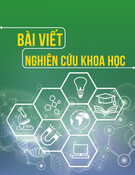


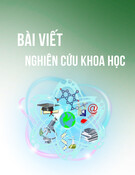


![Câu hỏi ôn tập môn Tâm lý học giáo dục [chuẩn nhất]](https://cdn.tailieu.vn/images/document/thumbnail/2025/20250710/kimphuong1001/135x160/59611752136982.jpg)
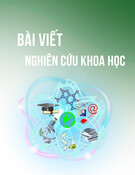

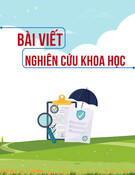

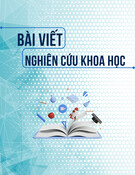
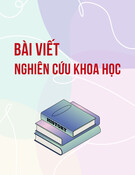
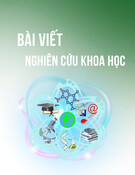

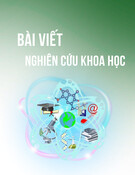


![Định hướng giáo dục STEM trong trường trung học: Tài liệu [chuẩn/mới nhất]](https://cdn.tailieu.vn/images/document/thumbnail/2025/20251124/dbui65015@gmail.com/135x160/25561764038505.jpg)
